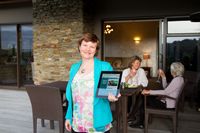The Changing Face of Tourism in New Zealand
New government funding, a National Tourism Plan, changes in the way travellers are booking, evolving demographics and a global hospitality revolution, are just some of the factors impacting local tourism businesses. Julia Charity reports.
The Tourism Indusry is a bedrock in New Zealand's Economy, earning $9.6 billion or 15.4% of New Zealand's foreign exchange earnings (year ending March 2012). Tourism directly and indirectly employs nearly one in ten New Zealanders (186, 900 jobs) with a total expenditure last year reaching $23.4 billion.
In a demonstration of confidence, an overall $158 million growth package to boost tourism was announced recently by Prime Minister John Key. Tourism New Zealand (TNZ) is working with tourism businesses, the Tourism Industry Association and other groups to create new opportunities and overcome barriers to growth in the sector.
While most of the package will be spent by government agency TNZ on marketing overseas – there are funds targeted toward attracting international business delegates, as well as high-value tourists.
TNZ chair, Kerry Prendergast says that implementation is underway in three core areas, starting with a revision of their three year marketing strategy. TNZ is seeking to increase the number of business events held in New Zealand. “We know from our research international delegates deliver the highest average daily spend of all visitors, spending over $3,000 during their visit.”
Recruitment is already underway in Southeast Asia, North America and China to sell New Zealand as a destination for conferences. Boosts to the economy are expected as business delegates spend time either before or after conventions travelling around New Zealand.
Towards a cohesive industry
Tourism Industry Association (TIA) chief executive, Martin Snedden thinks there will be considerable flow-on effects for the domestic market from the funding boost. Viewing tourism as a continuum of visitor experiences, which includes both international and domestic guests, there is a desperate need to promote cohesiveness right across the industry. TIA is taking a longer-term view, and commissioned a stakeholder-led National Tourism Plan to trigger sustainable economic growth.
“With no real glue in the tourism industry, no agreed high-level sense of direction, no end-to-end connection between supply and demand, the gauntlet has fallen to us to create an overarching framework that fills the need of a bigger plan,” says Snedden.
TIA has identified gaps between New Zealand’s international-facing marketing strategy; the government’s ‘Building Export Markets’ policy; local authorities individual tourism strategies and private sector businesses.
Research indicates that the most immediate value can be gained by better aligning existing activities towards identified opportunities, such as challenging the industry to undertake sustainable air connectivity as an immediate industry-wide priority. There is strong stakeholder support for a plan which the private sector takes ownership of and responsibility for, while recognising that public sector support is vital.
This view was endorsed by Destination Rotorua GM Oscar Nathan who says “the Government’s new funding is all about attracting new export dollars, and I totally understand that. But we do need to look at the robustness of the domestic tourism market.”
Formally involved as TIA’s deputy chair, Nathan welcomes the National Tourism Plan to recognise and solve problems collectively. RTO’s are having to find market driven, joint-venture campaigns: while underpinning the investments of local council and ratepayers and ensure that government initiatives are developed.
Changing face of hospitality
Meanwhile, specific sectors of tourism have undergone changes. Most significantly, the markets offering the best growth prospects are now predicted to be China, Australia, Germany and smaller emerging markets. Demographics also play a key role as globally, populations are aging, becoming increasingly affluent and technologically aware.
 Baby boomers showed the fastest rate of growth over the past five years, with a 17 percent leap in visitors aged 60 to 69 in 2012, according to MBIE. These older age groups will become even more significant in future as by 2031 the number of New Zealanders aged 65 and over is expected to exceed one million, almost double the current number.
Baby boomers showed the fastest rate of growth over the past five years, with a 17 percent leap in visitors aged 60 to 69 in 2012, according to MBIE. These older age groups will become even more significant in future as by 2031 the number of New Zealanders aged 65 and over is expected to exceed one million, almost double the current number.
International trends in Australia, Britain, and the US show that of all women travelling, about 60 percent are choosing to do so by themselves. These factors are fundamentally changing traveller expectations, and mature travellers and women are demanding experiences that are more enriching, meaningful and memorable.
Gina Paladini, director of Tomahawk, which specialises in marketing tourism online, comments on major changes to the distribution channels. “The Internet has allowed people to do their own research and book directly as opposed to always booking through an agent.” “Online review sites like TripAdvisor are increasingly important to cement decisions, 90 percent of which are made by women.”
The accessibility of accommodation booked online has surged and offerings extend beyond commercial accommodation. In New Zealand there are an estimated 2,000 Bed and Breakfasts (B&Bs), many of which are purpose-built, accredited to high standards and professionally run. B&B Association president Jenny Hoffman is proud of what they offer, with B&B operators some of the best ambassadors for New Zealand. “The concept and attitude to B&Bs have changed dramatically. This is particularly true as guests start to explore the less travelled parts of our country,” she says.
Martin Snedden values the importance of B&Bs and their contribution to the visitor experience but thinks the sector should seek cohesion so it can fully participate in the needs and the plan for the tourism industry going forward. Nathan agrees; “Certain destinations lend themselves to B&Bs and homestays, especially in and around cycle trails – but the sector is yet to fully mature.”
Globally there is a revival of the B&B and ‘Homestay’ concept, endorsed by hospitality networks like Couchsurfing and AirBnB, attracting over one million listings in more than 200 countries worldwide. Economically significant, AirBnB has grown to an estimated worth of $US2.5 billion since its inception in 2007.
 To meet the needs of the burgeoning mature and discerning guest market here in New Zealand, a simple online concept has been on trial since 2011. Launched ahead of the Rugby World Cup, the ‘Look After Me’ website works like a bed and breakfast version of TradeMe, where guests can browse and book accommodation. The hospitality network is growing quickly, now with rooms in every major city centre.
To meet the needs of the burgeoning mature and discerning guest market here in New Zealand, a simple online concept has been on trial since 2011. Launched ahead of the Rugby World Cup, the ‘Look After Me’ website works like a bed and breakfast version of TradeMe, where guests can browse and book accommodation. The hospitality network is growing quickly, now with rooms in every major city centre.
‘Look After Me’ has sought to understand and respond to opportunities in the mature consumer market by aligning with the Cycle Trail network and developing key relationships as an accommodation provider for the rebuild of Christchurch and major national events.
With a global study finding New Zealand ranked first equal (with Iceland) as being the most welcoming to tourists, New Zealand is gearing up for even more changes.
“There isn’t any reason why New Zealand shouldn’t aspire to be the homestay capital of the world,” says Kerry Prendergast.
Julia Charity is a Rotorua-based entrepreneur and writer.
Email: julia@lookafterme.co.nz

